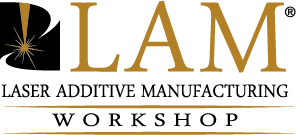During LIA’s Upcoming LAM Workshop
By Michelle L. Stock
Additive manufacturing has been creating buzz for some years, and is now on the threshold of becoming mainstream. According to a Pricewaterhouse Coopers survey of more than 100 manufacturing companies in 2014, 11 percent had already moved to volume production of 3D printed parts or products. With interest only increasing based on maturing technologies and processes, there has never been a better time to learn the latest about laser additive manufacturing, meet and network with experts, and benchmark laser additive manufacturing against other technologies – and no better place than LIA’s fast-approaching Laser Additive Manufacturing (LAM®) Workshop.
The two-day event, held on March 2-3 in Orlando, FL, will focus on the question “why lasers?” in the burgeoning field of additive manufacturing. Through its keynotes, sessions, exhibits and networking opportunities, the workshop will answer that question and many more. For people involved in manufacturing of complex, lightweight, metal and other structural materials, LAM is a must-attend event.

LAM provides great networking opportunities with experts in the AM industry during the Exhibitor Reception
Paul Denney (Lincoln Electric) General Chair of this year’s LAM, along with his Co-Chairs Ingomar Kelbassa (Fraunhofer ILT) and Jim Sears (GE Global Research Center) have designed the program to look at how people are using additive manufacturing, and where, when and why lasers are the best solution when compared to other technologies. Denney commented, “We are hoping this year’s workshop will help attendees better understand the pros and cons of laser-based additive manufacturing over other technologies. Hopefully it will also provide direction to those looking to improve on the status of the laser additive manufacturing and what technologies need to be developed and/or improved upon.” Users from all industries that require structural materials, such as oil and gas, aerospace, agriculture automotive, defense, marine, medical device, transportation, power generation, construction, and tool and die, can benefit from the knowledge gained by attending LAM. Whether focused on relatively small parts like medical implants and special lightweight brackets for planes, or much larger parts being made directly or that are having their surfaces modified, the program will provide an overview on the different options that are out there today to create formed parts and why you would choose each.
This year’s workshop kicks off with a keynote presentation by Professor Sudarsanam Suresh Babu of The University of Tennessee at Knoxville, presenting Recent Advances in Metal Additive Manufacturing at a Manufacturing Demonstration Facility: Role of in-situ Process Monitoring, Computational Modeling, and Advanced Characterization. Following the keynote, speakers from companies who are involved in alternative technologies to laser additive manufacturing will present, including companies using gas metal arc welding (GMAW), ultrasonic welding and electron beams. With that background in mind, the program will turn to how companies select the “best” additive manufacturing process(es). The program will continue with a session on the latest in additive equipment directly from major manufacturers, including Concept Laser and Optomec, Inc., followed by a session on new additive approaches from both academia and industry experts, such as wire-fed additive manufacturing that can produce features the size of a match-head. The first day will be capped by an excellent opportunity to network – the Exhibitor Happy Hour Reception.
The second day will address “bridging the gap” of laser additive manufacturing from research to application. Starting off, a keynote address by Professor David Bourell of The University of Texas at Austin, Director of the Laboratory for Freeform Fabrication, will discuss the current status of additive manufacturing. The morning sessions will provide insights from government, corporate and academic labs and how they are taking innovations from the lab to the factory floor. In the afternoon, the topics will shift to job shops and how they use additive manufacturing for their customers. This portion of the event will hold particular interest for those who wish to start developing prototypes and even production parts using additive manufacturing processes, but do not know where to begin and are not ready to commit to purchasing equipment. The workshop will close with the latest in process monitoring and control, two very important aspects to developing robust manufacturing processes.
Peter Baker, LIA’s executive director, is excited about this year’s workshop, stating “Now in its 8th year, LAM has become a premier event in the additive manufacturing arena. We are grateful to the contributors and sponsors who create this valuable workshop.”
Of special note to those involved in medical applications, LAM General Chair Denney adds, “While LAM 2016 does not specifically have a medical focus, those in this industry sector may find the workshop of interest. Technology in sessions on new processes, monitoring-control, research facilities and equipment advances may be of benefit to those in the health care arena. LAM 2016 also provides many networking opportunities to meet with professionals involved in the next generation of processes, equipment and controls that will be used in the medical services market.”
Whether you want to learn more about laser-based powder-bed, powder-fed and wire-fed processing, what the latest materials are for use in these processes, or what the latest additive manufacturing trends are by job shops and industrial manufacturers, LAM 2016 is the conference you will want to attend this year. Visit the LIA website (www.lia.org/lam) for more information and to register today.

